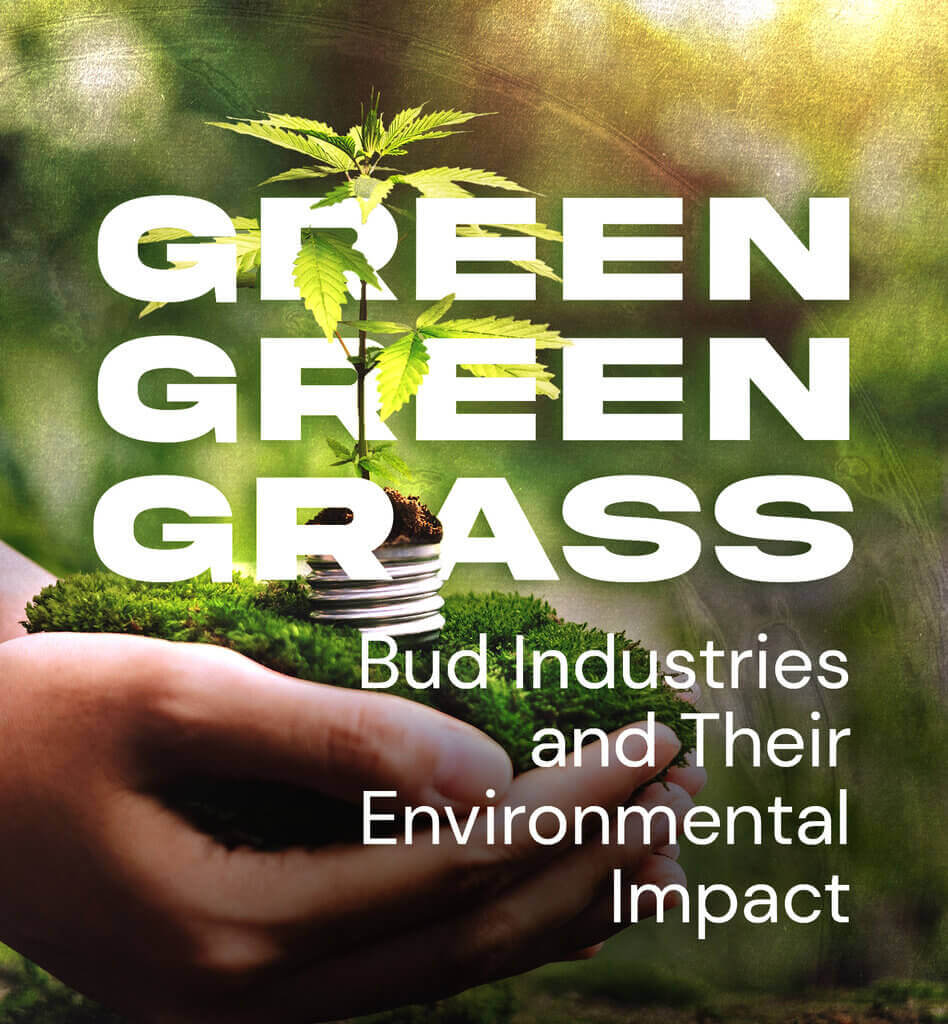JACKSONVILLE BEACH, Fla. – In a world where the sweet, skunky aroma of marijuana fills the air, weed can bring peace and chill vibes to everyone who takes a toke. Amidst this cloud of euphoria, a not-so-funny secret lurking in the shadows – the environmental impact of the bud industries arises.
Unfortunately, when it comes to cannabis cultivation techniques, the stakes are pretty “high” for the environment.
The Thirsty Truth
With the legalization of marijuana in more than 50 countries and U.S. states, cannabis farming has skyrocketed.
Along with that surge is an increased demand for water. Yes, indoor and outdoor bud industries cultivation is a notorious water hog.
A study published in the Journal of Cannabis Research, marijuana farming’s high water demand can lead to pollution and diversion, potentially harming ecosystems.
Each plant is estimated to require six gallons of water daily during the growing season. With numbers like that, it’s no wonder the environment feels parched.
The Smelly Side of Pot – Ozone, VOCs, and Funk
Marijuana’s characteristic smell is distinct and can be pretty intense. But many don’t realize that the plant emits volatile organic compounds (VOCs) that can contribute to ozone formation.
Researchers in Denver estimate that cannabis cultivation could double the city’s annual VOC emissions, reaching 520 metric tons and producing 2,100 metric tons of ozone. And that’s just from 10,000 plants per facility.
Issues with Soil Degradation
Cannabis production is one of several conventional agricultural practices that can result in soil deterioration that endangers nearby ecosystems. This includes increased acidity, nutrient loss, decreased organic carbon stored in the soil, and soil erosion.
By promoting policies that maximize hemp’s environmental advantages, the cannabis sector can contribute to the resolution of this problem. The soil will remain healthy with careful land use planning and regular testing. The sector can also implement components of regenerative agriculture, which links farming and natural systems, to help preserve the soil’s viability.
Watering Practices Lead to Issues
Water is obviously necessary for the farming of cannabis and hemp. The majority of watering is accomplished using supplies from artificial irrigation. This may result in agricultural runoff, which can contaminate neighboring soil, watersheds, and surface waters with high levels of herbicides, insecticides, heavy metals, surplus nutrients, and wastewater pollutants.
Indoor gardening has unique water problems. By releasing excessive fertilizers and industrial cleansers, indoor growing facilities can put a strain on municipal water systems. Additionally, this adds to the strain on neighborhood wastewater systems, which can increase energy demand and the emissions of greenhouse gases (GHG) from fossil fuel-burning power plants.
The bud industries can address this by using only the minimal amounts of water required for irrigation and constructing an automated irrigation system with water diversions that recover and reuse water. The latter minimizes water consumption and runoff, limiting its influence on water quality and public health. It remains to be seen if this will be accomplished by regulatory changes or industry self-regulation.
Pest Control Gets Lit, But Not in a Good Way
Another unwanted byproduct of marijuana production is rodents. In the quest for the perfect bud, cannabis farmers often face that age-old enemy.
These furry foes can wreak havoc on plants and water lines, and their presence can lead to the use of harmful pesticides that pose risks to the environment.
New diseases and pests are being reported, like the autumn armyworm, while farmers are still navigating and absorbing the USDA Final Rule controlling industrial hemp production in the United States.
On the other hand, a deer mice, which love cannabis and are predators, are on the rise in Pennsylvania. These mice may be deadly to crops during vulnerable stages of growth and development, suggesting growers may face a challenging start to the agricultural season. The difficulty of identifying the footprint of deer mice for both indoor and outdoor farmers of Cannabis species within the Cannabaceae family is one obstacle linked with this new concern for a recently domesticated crop.
In addition to damaging indoor production environments, the plant-loving deer mice can force a farmer to replant and potentially miss the full production schedule if the pest is not promptly controlled. Deer mice left their footprints during the seed emergence and seedling stages, which suggests that Peromyscus species may be interested in cannabinoids in young plants if they are dissatisfied with the cannabinoid content after consuming ungerminated seeds.
Thankfully, eco friendly labels of pest control methods are available to help protect both the crop and the land on which it grows.
Logistics Is Another Issue
Transporting cannabis harms the environment, which has an effect on how sustainable it is. Federal law forbids it from doing so, but some state restrictions also make transit even more difficult. For instance, California legislation mandates that cannabis travel via four different modes of transit before reaching the consumer:
-
Farmers of cannabis deliver their goods to processors.
-
Distributors get the product from processors.
-
Transporters deliver to retail marijuana dispensaries.
-
Customers take the retail marijuana home with them to use.
In order to allow more direct pathways to the end user and increase the sustainability of cannabis growing, cannabis bill and legislation changes at the state and national levels are required. As a result, less transportation and touchpoints would be required to transport cannabis from the farm to the customer, lowering associated air pollution and carbon footprint.
Green Green Grass Grows the Ganja – Sustainability Strikes Back
So, what’s a responsible cannabis farmer to do?
Organic cannabis cultivation techniques that avoid synthetic pesticides and fertilizers are another vital aspect of eco-friendly cannabis farming. Growers can maintain soil health and prevent nutrient depletion by implementing regenerative agriculture techniques.
We can minimize the bud industries environmental footprint by reducing water use, employing renewable energy sources like solar power, and using energy-efficient LED lighting for indoor growth. But for the bud industries to honestly go green, it’ll take more than just farmers embracing sustainability.
Governments can establish guidelines and regulations for eco-friendly cultivation, while industry stakeholders can collectively share knowledge, resources, and best practices to reduce their environmental impact. Collaboration is critical to ensuring a brighter, greener future for cannabis farming.
Making Cannabis Green Again
Some cannabis farmers are already making strides toward sustainability. In California, contract cannabis farming focusing on environmentally friendly cultivation methods is gaining popularity.
The sector as a whole has sustainability concerns, notwithstanding the positive environmental effects of hemp and cannabis. These include inefficient shipping and packing regulations, excessive plastic waste, and energy-hungry indoor growth. Fortunately, changes to federal and state legislation that loosen some of the restrictions on the bud industries can quickly address these problems.
Even though you might not be able to modify the law to help the cannabis sector become more sustainable, you can contribute by removing carbon from the atmosphere to help mitigate some of its environmental problems.
This shift towards sustainable agriculture is a positive step for the industry and the environment.
As more states in the U.S. legalize adult-use cannabis, the industry must continue to prioritize sustainable practices.
In 2022, nearly $3 billion in retail of cannabis business tax were collected, highlighting the potential economic benefits of the bud industries. However, growers must ensure that this growth doesn’t come at the expense of the environment.
By splashing down our water usage, giving the boot to pesky pests, and embracing eco-friendly cannabis cultivation techniques, forward-thinking leaders can help transform the bud industries into an environmentally-conscious powerhouse. In time, the world could see Mary Jane and Mother Earth as BFFs, working organically to coexist.
Here’s More Information on the Topic:
The Environmental Downside of Cannabis Cultivation
https://daily.jstor.org/the-environmental-downside-of-cannabis-cultivation/
Pot, Water Theft, and Environmental Harms in the US and Mexico
https://www.brookings.edu/articles/pot-and-water-theft-and-environmental-harms-in-the-us-and-mexico/
The Environmental Impacts of Marijuana in California
https://fse.fsi.stanford.edu/news/environmental-impacts-marijuana-california


